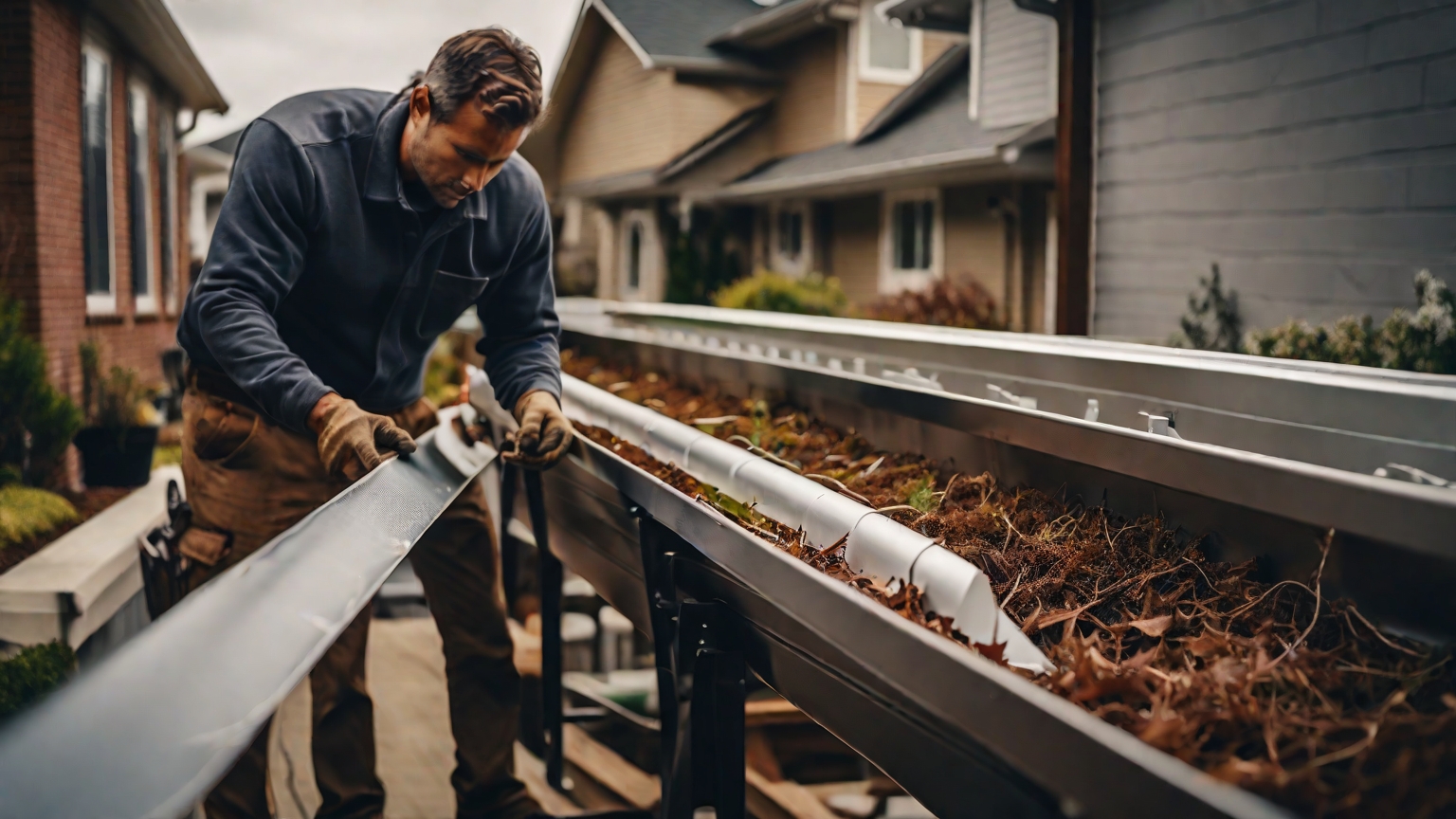Gutter Installation – Choosing the right Size and shape
Correctly sized gutters are crucial to safeguarding the integrity of your roof, foundation and home structure. Selecting an optimal size requires taking into account factors like roof drainage area, gutter slope decline and average rainfall rates in your region.
To accurately size gutters on your roof, access its fascia and mark the lowest point in each run of guttering. Use a chalk snap line to draw an inclined line between these points (as depicted).
Choosing the Right Gutter Size
Selecting the ideal gutter size is an essential component of the installation process. A gutter that is too small will not be able to effectively manage the rainwater flow from your roof; while selecting too large a size could overflow and cause water damage to your home’s structure. There are various factors which help in determining this decision such as your roof pitch, region’s rainfall pattern and architectural style of your home that go into determining it.
Initial calculations must include determining your drainage area’s square footage to ascertain what size gutter you require for order. With this information in hand, it can then be used to plan how many runs and their length you require – keeping in mind that guttering should slope towards downspouts so water drains away from your home effectively; an inch drop for every 20 feet run would be optimal.
Next, determine how much drainage your roof has. You can do this by measuring the distance from gutter to downspout or by using a tape measure and level. After doing this, use chalk snap line to draw a slope line on fascia board using chalk snap lines.
Last but not least, you must understand the dimensions of your downspouts. Downspouts play an integral part in carrying rainwater away from your home and must remain large enough to transport it away without becoming overwhelmed or overflowing. To avoid this happening, select downspouts that match up well with the size and style of gutter you have; for instance a 5-inch gutter would need downspouts 2-inches by 3-inches in size.
If you need assistance selecting the appropriate gutter size and type for your property, consulting with an experienced roof and gutter installer could be invaluable. An expert can guide your decision while offering expert advice about which downspout will meet your specific needs best – giving you peace of mind knowing your new gutters will function smoothly and efficiently.
Calculating Your Gutter’s Length
If you’re planning on replacing or installing new guttering in your home, some key measurements need to be taken prior to ordering materials. Incorrectly sized gutters can lead to serious water overflow problems as well as clogging and structural damage; this guide will walk you through each step in calculating gutter length for optimal drainage capacity for your home.
First step to calculating gutter length: determine roof surface area. This can be accomplished by measuring from end-to-end of roofline from one end. Take note of any projections or obstructions that might exist on roofline that could impact measurement taken.
Once you know the width of your roofline, the next step should be determining how many downspouts will be necessary for your gutter system. As a general guideline, one downspout is recommended every 25 to 35 linear feet of gutter run; however if your area experiences high rainfall levels or your roof pitch is steep it may be beneficial to increase this number of downspouts.
Once you know the amount of drainage capacity your home requires, the next step should be choosing a type of guttering to use. Domestic gutters in the UK come in various sizes that range from 112mm half-round gutters to 115mm square and K-style styles; each style offers advantages and disadvantages that must be carefully considered before selecting one for use in your home. Choosing incorrectly could have adverse repercussions for drainage capacity – so for best results always consult a professional tradesperson in finding an optimal solution that suits you home.
Pitch factor of your roof is also an integral component of calculating gutter size. As more your roof slopes, so will its gutter size; in order to accommodate an increase in water flow. Calculation can easily be accomplished using a two-foot spirit level by measuring distance between ground and top of roof then multiplying this figure by roof pitch to determine roof surface area.
Choosing the Right Material
When it comes to gutters, there is an assortment of materials, sizes, and shapes available for you. Consult a gutter expert in order to choose one that best fits with the architecture, climate conditions and budget of your home.
Aluminum gutters are an economical and sturdy material choice, with low costs and easy maintenance requirements. Resistant to corrosion, aluminum sectional systems were popular among homeowners before seamless gutter manufacturers offered seamless options that are less prone to leaks and clogs.
Seamless gutters are made by using an on-site machine to produce long stretches of gutter without seams, making this type of system possible. To make the most of seamless gutters, look for an installer with experience installing this type of system locally.
Gutters should be secured to the fascia – which is the board running along the lower edge of a roof – using brackets or hangers, with their inward slope slightly tilted toward downspouts to promote water flow and protect home structures from being compromised by leaky gutters. Proper installation ensures maximum effectiveness in protecting against water damage to homes from runoff.
Downspouts should be installed at strategically chosen points along gutters in order to direct water away from the home and prevent erosion and protect its foundation. They should ideally carry at least five feet of the flow away, thus helping prevent soil erosion while safeguarding home structures from any further harm.
Consideration should be given to both the type and number of downspouts when selecting a gutter system, since too few may cause clogs while too many could render your system ineffective. Most professionals recommend having one downspout per 20 feet of gutter.
Most gutter systems are composed of metal, and there are various options available when choosing materials for their construction. Aluminum is often chosen because it’s affordable, lightweight, rust-resistant and holds up well in most weather conditions.
Vinyl gutters tend to be less costly, yet are prone to cracking in extreme cold and degrading over time. More durable metal options such as copper and zinc require more upkeep but can last 90 years or longer with proper care.
If you select a sectional aluminum gutter system, sealant at its seams will be necessary to prevent leakage. Conversely, seamless systems are soldered together at each seam and do not need sealants at their joints to ensure maximum performance.
Choosing the Right Downspouts
Downspouts are essential components of your gutter system, helping direct rainwater from it directly into the earth without oversaturating it and leading to soil erosion or foundation damage. But clogged downspouts could clog your system further so it is important that you select appropriate models for your home.
Selecting suitable downspouts can be a challenging endeavor, particularly given that every home varies greatly. Factors like your yard’s slope and proximity to features like hose bibs, sidewalks, electric meters and other outdoor features will ultimately determine where they need to go – without proper planning they could end up too few or too many or not placed properly so your gutter system functions efficiently.
Gutter downspouts can be made of various materials. Aluminum is lightweight and long-lasting; copper boasts style while being highly durable, developing an eye-catching patina over time. Galvanized steel offers affordable durability yet remains susceptible to corrosion or rust issues; vinyl offers budget-conscious homeowners another cost-cutting alternative; yet remains less resilient in comparison.
When choosing downspouts, positioning should always be your top priority. Make sure they drain far enough away so they do not cause any issues for your home; otherwise, water may eventually overflow from their respective gutters onto the ground around your property, leading to seepage into basements or cracking foundations.
To ensure that your downspouts are correctly located, begin by measuring and marking the length of your gutter system and noting where they need to go on your fascia board. Use a level to check that they’re at their appropriate angles, while use of gutter sealant is key to prevent leaks at seams and joints.





